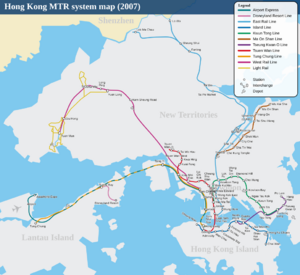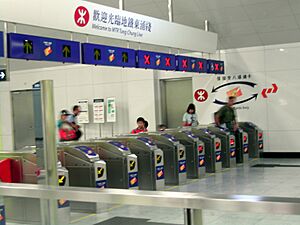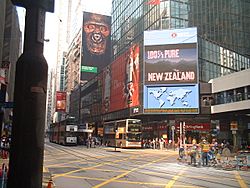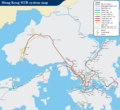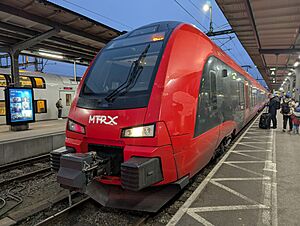MTR Corporation facts for kids
 |
|
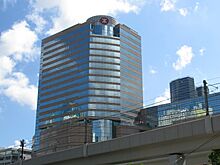
Headquarters in Kowloon Bay, Hong Kong
|
|
|
Formerly
|
Mass Transit Railway Corporation (1972–2000) |
|---|---|
| Public; Government-owned corporation | |
| Traded as |
|
| Industry | |
| Founded | 22 September 1972 |
| Headquarters | Kowloon Bay, |
|
Area served
|
Worldwide, including: |
|
Key people
|
|
| Revenue | |
|
Operating income
|
|
| Total assets | |
| Total equity | |
| Owner |
|
|
Number of employees
|
31,822 (2024) |
| MTR Corporation | |||||||||
|---|---|---|---|---|---|---|---|---|---|
| Traditional Chinese | 香港鐵路有限公司 | ||||||||
| Simplified Chinese | 香港铁路有限公司 | ||||||||
| Literal meaning | Hong Kong Railway Corporation Limited | ||||||||
|
|||||||||
MTR Corporation Limited is a big company in Hong Kong. It is mostly owned by the government. MTR runs the Mass Transit Railway, which is Hong Kong's most popular way to get around. The company also builds properties like shopping malls and homes.
MTR is listed on the Hong Kong Stock Exchange. This means people can buy shares in the company. MTR also helps run railways in other parts of the world. These places include London, Stockholm, Beijing, Hangzhou, Macao, Shenzhen, and Sydney. It also operates a train system in Melbourne.
MTR's Story
The Mass Transit Railway Corporation was started on September 22, 1972. It was a government company. Its job was to build and run a railway system for Hong Kong. This system was needed to help people travel easily.
On June 30, 2000, the company changed its name to MTR Corporation Limited. Its main job stayed the same: to run the railway. On October 5, 2000, MTR shares were sold to the public for the first time. This made it a public company. However, the Hong Kong government still owns most of it.
Becoming a Public Company
On September 11, 2000, the Hong Kong government announced that MTR would sell some of its shares. This was called a partial privatisation. It meant that regular people could buy parts of the company.
One billion shares were offered at first. But because so many people wanted to buy them, 1.15 billion shares were sold. On October 5, 2000, the company was listed on the Hong Kong Stock Exchange. About 600,000 people became shareholders. In June 2001, MTR became part of the Hang Seng Index. This is a list of major companies in Hong Kong.
MTR has been a very successful company. It is one of the few public transport systems in the world that makes a profit. In 2024, MTR made a profit of HK$15.8 billion (about US$2 billion).
Joining Forces: MTR and KCRC
There were talks about combining the MTR Corporation with another government-owned railway company. This was the Kowloon-Canton Railway Corporation (KCRC). The idea was to make Hong Kong's transport system work better. MTR liked the idea, but KCRC did not. In March 2004, the Hong Kong government encouraged them to merge.
On April 11, 2006, the government shared the details of the plan. KCRC would let MTR run its railway system for 50 years. KCRC would get a payment of HK$4.25 billion upfront. It would also get yearly payments. MTR would also pay HK$7.79 billion for KCRC's properties.
The KCRC lines were not as profitable as MTR's. KCRC also did less property development. The government wanted to avoid criticism for selling KCRC's assets too cheaply. So, they decided to lease the operation rights instead of selling KCRC.
On December 2, 2007, MTR's Chinese name changed to "Hong Kong Railway Corporation Limited." The English name stayed the same. KCRC became a holding company, meaning it no longer ran trains itself. MTR shareholders approved the merger on October 9, 2007. The agreement is for 50 years. This merger also changed the system's Chinese name from "Subway" to "Hong Kong Railway."
Fairer Fares for Everyone
After the merger, many passengers benefited from lower fares. People using an Octopus Card (a smart payment card) saw their fares drop. Students and those with special passes also got even bigger discounts. Elderly Octopus card holders received a new special fare. They could travel anywhere on the MTR network for only $2. This did not include the Airport Express, Light Rail, or cross-border stations.
How MTR Makes Money
MTR uses a special way to make money called "Rail + Property." This means they earn money from running trains and from developing properties. This model was first used to help pay for the original MTR lines. It was thought that property would make up about 20% of MTR's total income.
The government decided how land above MTR stations should be used. It was not just for private homes to make MTR more money. It could also be used to build public housing. This helped solve housing issues in Hong Kong. Property income was meant to be a backup fund. It was for unexpected costs, like if building railways cost too much.
By 2017, about 40% of MTR's income came from property. The way property income was used changed over time. It started being used to help pay for daily operations and new stations.
Who Leads MTR?
- Chairman: Rex Auyeung (since July 2019)
- Chief Executive: Jacob Kam (since April 2019)
Past Leaders
Former Chairmen
- Sir Philip Haddon-Cave (1972–1974)
- Sir Norman Thompson (1974–1983)
- Sir Wilfrid Newton (1983–1989)
- Hamish Mathers (1989–1995)
- Jack So (1995–2003)
- Raymond Ch'ien (2003–2015)
- Frederick Ma (2016–2019)
Former Chief Executives
The role of Chief Executive started in 1995.
- Jack So (1995–2003)
- Sir Chow Chung-kong (2003–2011)
- Jay Walder (2012–2014)
- Lincoln Leong (2015–2019)
MTR Around the World
MTR operates railway services in several countries.
Hong Kong Operations
On October 5, 2000, MTR became the first railway company in Hong Kong to sell shares to the public. Before this, the Hong Kong government owned all of it. MTR Corporation runs the MTR system. Since December 2, 2007, it also runs the Kowloon–Canton Railway.
The train lines make money. But MTR gets most of its profits from property development. These properties are usually built next to railway stations. MTR also earns money from other businesses in Hong Kong. This includes renting out space for shops and advertisements.
Train Services
The Mass Transit Railway (MTR) is Hong Kong's main train system. It first opened in 1979. As of September 2024, the system has 271 kilometers (168 miles) of tracks. It has 167 stations, including 99 railway stations and 68 light rail stops. There are also plans for new lines in the future.
Property Business
Property is a very important part of MTR's business. It brings in most of the company's profits. For example, in 2009, MTR made HK$7.3 billion in profit. Of that, HK$3.55 billion came from property.
MTR develops land near its railway projects and existing lines. For instance, land in West Kowloon was turned into Union Square. This area has homes, offices, shops, and hotels. It includes the International Commerce Centre, which is Hong Kong's tallest commercial building.
The famous International Finance Centre in Central is also managed by MTR's property team.
Shopping Malls
MTR Corporation has built many large shopping centers near its stations. One example is PopCorn mall at Tseung Kwan O station. It connects to nearby malls, homes, and hotels. Another is Maritime Square at Tsing Yi station. This mall has a nautical theme. It includes supermarkets, shops, bookstores, a cinema, and restaurants.
Maritime Square is easy to reach because Tsing Yi station is a major transport hub. Other shopping centers managed by MTR include CityLink, Elements, and Telford Plaza. As of 2023, MTR Corporation owns 13 shopping malls in Hong Kong.
Sweden Operations
MTR Nordic AB is an MTR company based in Stockholm, Sweden. It runs public transport services through different smaller companies.
Current Operations (Ending November 2025)
- MTR Tunnelbanan AB runs the Stockholm Metro. MTR started operating the metro on November 2, 2009. The current contract to run the metro ends in November 2025.
- MTR Tech AB takes care of maintaining the trains for the Stockholm Metro.
Past Operations
- MTR Express (Sweden) AB (2015–2024) ran long-distance trains between Stockholm and Gothenburg. These trains were called MTRX. The service started on March 21, 2015. MTR sold this business in May 2024.
- MTR Pendeltågen AB (2016–2024) operated the Stockholm commuter rail network. MTR was in charge of the network, trains, and stations. This contract ended early in March 2024.
- MTR Mälartåg AB (2021–2024) ran regional trains called Mälartåg. MTR decided to end this contract early in 2024.
Australia Operations
- Melbourne: In June 2009, MTR (with 60% ownership) and its partners were chosen to run the Melbourne suburban railway network. They took over on November 30, 2009. The contract was extended until November 2024.
- Sydney: In June 2014, MTR (with 60% ownership) and its partners were chosen to operate the Sydney Metro Northwest. MTR and its partners formed Metro Trains Sydney to run the services for 15 years. The North West Rail Link opened in May 2019. It was extended through the city center in August 2024.
Mainland China Operations
MTR runs nine train lines in three cities in mainland China.
Beijing
MTR has a joint company called Beijing MTR Corporation Limited. MTR owns 49% of it. This company builds and operates several lines of the Beijing Subway for 30 years. These include Line 4, Daxing line, Line 14, Line 16, and Line 17.
Hangzhou
MTR also has a joint company in Hangzhou called Hangzhou MTR. MTR owns 49% of this company. It operates Line 1 of the Hangzhou Metro for 28 years. MTR owns 60% of the company that operates Line 5 of the Hangzhou Metro.
Shenzhen
MTR agreed to build the second part of Line 4 of the Shenzhen Metro. It also operates the entire line for 30 years, starting from July 1, 2010. The second part of Line 4 opened on June 16, 2011. Line 13, which started running on December 28, 2024, is also operated by MTR Corporation (Shenzhen).
Former Operations
United Kingdom
- Elizabeth line: In May 2015, MTR started an eight-year contract to operate the Crossrail service in London. Before the new lines opened, MTR ran services between Liverpool Street and Shenfield, and Paddington and Heathrow Airport. These were called TfL Rail. In May 2022, services started between Paddington and Abbey Wood. All services were then renamed the Elizabeth line. As of 2024, MTR Elizabeth line operates this service. However, MTR lost its bid to continue operating the Elizabeth line. Another company took over operations on May 25, 2025.
- London Overground: MTR and Laing Rail formed a joint company to bid for the London Overground contract. They won and operated the service from November 2007. Later, another company, Arriva, took over Laing Rail's share. MTR bid to run the London Overground again in 2015 but did not win. Arriva Rail London took over full operation in November 2016.
- South Western Railway: In August 2017, South Western Railway started operating. MTR owned 30% of this company, which was a joint venture with FirstGroup. In December 2024, it was announced that the government would take over this railway in May 2025.
Macau
 |
|
| Public company | |
| Industry | Transport |
| Founded | 11 April 2018 |
| Defunct | December 31, 2024 |
| Headquarters |
Taipa
,
Macau
|
|
Area served
|
Macau |
MTR Railway Operations (Macau) Company Limited was a company fully owned by MTR Corporation. It operated the Taipa line of the Macau Light Rapid Transit (MLRT) in Macau. MTR ran this line from its opening on December 10, 2019, until 2024. MTR was contracted to operate and maintain the line for 80 months. However, in 2024, MTR gradually handed over the operations to a company owned by the Macau government.


